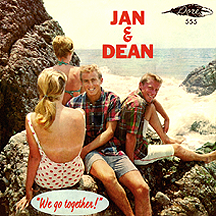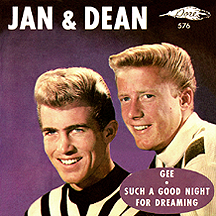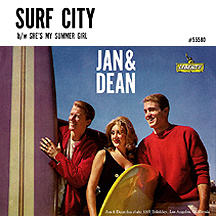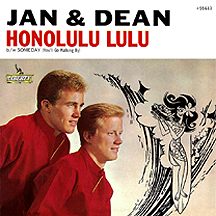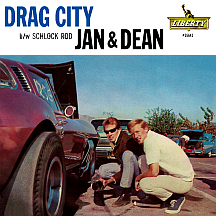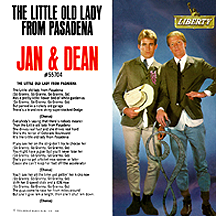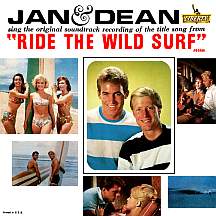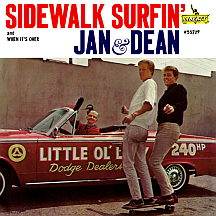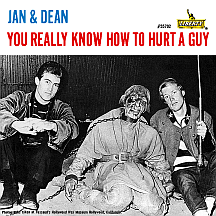JAN AND DEAN
Jan Berry and Arnie Ginsburg decided they had what it took to be a music act. How hard could it be? Seems Arnie had come up with a song based on a real person...a stripper named Jennie Lee, "The Bazoom Girl," charter member of the "League of Exotic Dancers." Arnie, 18 years old and sowing a few wild oats, had caught her act at an L.A. burlesque club. It was 1958; Jan was still in high school and missed out on Arnie's "adult" excursion. The guys got together in the garage at Jan's home in Westwood with an Ampex reel-to-reel recorder Jan's dad had gotten him. They began harmonizing, doo wop style, while another friend, Donald Altfeld, supplied makeshift percussion (banging on sticks). A primitive, echo-drenched version of "Jennie Lee" was the result.
It didn't take much effort on the part of Jan and Arnie to get the song released on Arwin Records, owned by Doris Day's husband Marty Melcher. Joe Lubin, A&R man for the Hollywood-based label, heard the tape and felt strongly enough about its potential that he got together with the guys to do a more polished version, yet insisted on duplicating the sound he heard on the tape. An all night session with Lubin in Jan's garage produced a second take as well as "Gotta Getta Date," written on the fly by the three and recorded in the early morning hours for use as the single's B side. Back in the studio, Lubin hired the best session men in town (guitarist Rene Hall, saxophonist Plas Johnson, pianist Ernie Freeman and drummer Earl Palmer) and overdubbed the band for the finished product. It was an unconventional way to make a record, but not all that uncommon in the early rock and roll environment of the late '50s.
The song caught on, hit big (top ten in June '58), and Berry and Ginsburg found themselves appearing onstage doing rock shows with some of the hottest names of the era in a blur of bright lights and adoring female fans that began to affect Arnie in a stressful, emotional way. Not everyone, it seems, is cut out for instant stardom. Jan was fine with it. The follow-up, "Gas Money" (Altfeld shared writer credit with Berry and Ginsburg on this one), hit the charts less impressively while hinting at a car-and-hot-rod direction the act (or Jan at least) would explore more deeply in the future. The third Arwin single didn't sell and the duo appeared to be done, which was okay by Arnie, mentally and physically drained and ready to move into a less manic vocation. He quit to attend the University of Southern Cal, leaving Jan, wound up and ready for more, with the task of finding another singing partner.
An old football buddy, Dean Torrence, had just returned from six months' initial training with the U.S. Army Reserve and was game to take over where Ginsburg left off. The two had met at Emerson Junior High in Westwood several years earlier, playing on the school football team there and at University High School right up through graduation. Locker room harmonizing had become a regular routine with other school athletes joining in; roughhousing on the gridiron, singing in the showers. A school club called The Barons, counting Jan, Dean, future actor James Brolin and pounding-drum devotee Sandy Nelson among its members, did some impromptu singing as well. It was a no-brainer in 1959 for Jan and Dean to attempt to continue what Jan and Arnie had begun.
Budding record industry everyman Kim Fowley, another classmate of Jan, Arnie and Dean at University High, recommended the new duo to Lou Adler and Herb Alpert, producers at Los Angeles label Dore (upon meeting them, Adler said they had a "very California look" in contrast to the Philadelphia breed of teen idols saturating the biz at the time). For "Baby Talk" (penned by Melvin Schwartz), a recent release by Brooklyn doo wop group The Laurels, Jan and Dean put more emphasis on the song's nonsense baby syllables; their version hit the national top ten in September 1959. Several follow-up singles on Dore appeared on the charts in '59 and '60: Alpert and Adler's "There's a Girl," the oldtime standard "Clementine" (eclipsed by Bobby Darin's rendition, released at about the same time) and two older R&B hits-turned-teen-tunes, The Moonglows' "We Go Together" and The Crows' "Gee."
With a solid track record, Jan and Dean approached Liberty, one of L.A.'s top record companies, in the hopes of working with the label's bigtime hitmaking team and securing longer-term success. A demo of Hoagy Carmichael and Frank Loesser's 1938 tune "Heart and Soul" done up J&D style was rejected by the label, though they were interested in signing the duo. The two instead took the song to Gene Autry's Challenge Records, relying on their gut instinct that it would be a hit (even though a version by The Cleftones was already scaling the charts). It was; number one in Los Angeles in June '61 and a top 30 hit nationally (the markedly different-sounding Cleftones record did reach the top 20 a few weeks earlier, winning the overall competition). After one other Challenge 45, "Wanted, One Girl," Jan recorded a solo single, "Tomorrow's Teardrops," released by Alpert and Adler on a "just for fun" label, Ripple Records. In late 1961, Jan and Dean signed a long-term contract with Liberty.
Early Liberty efforts were a bit directionless as they stayed with the previously established formula. "A Sunday Kind of Love" (a Louis Prima standard best known through Jo Stafford's 1947 hit and a 1953 R&B version by New York group The Harptones) hit the charts briefly in early 1962. "Tennessee," with a doo wop hook not unlike the ones in "Jennie Lee" and "Baby Talk," had a slightly better run a few months later. "Linda," written in the '40s by Jack Lawrence, showed promise when adjusted to Jan and Dean mode in spring 1963, a top 40 hit but just the third overall among more than a dozen releases since '59.
The Beach Boys had been together for two years and were really heating up at about this time, opening for Jan and Dean in concert and serving as the duo's backing band onstage. Jan began writing songs with the group's leader Brian Wilson and their composition of "Surf City" opened the world of surf music to J&D and hit number one on the charts in July '63. Suddenly Jan and Dean and the Beach Boys were competing with one another...and the leader of the latter was consorting with the enemy! Of course it was a friendly rivalry and Wilson continued to contribute songs, usually in collaboration with Berry and Roger Christian, a songwriter and well-known Los Angeles disc jockey. "Honolulu Lulu," a Berry-Christian-Spunky song ("Spunky" being another case of Lou Adler just "having fun"), was a fall '63 hit in the surf-and-beach vein, then Jan and Dean took the next logical step into the drag race craze (as the Beach Boys had done on the B sides of their last few surf hits) with the first of several hot rod and/or car songs. "Drag City," written by Berry, Christian and Brian Wilson, went top ten in January 1964.
Jan Berry began writing and producing outside acts, among them The Matadors, who backed Jan and Dean on many of their studio recordings. He and Art Kornfeld composed The Angels' 1963 hit "I Adore Him" and with Christian he contributed "Three Window Coupe" to The Rip Chords' run of car song smashes in '64. Dean Torrence went in another direction during what little free time he had, attending USC and studying a number of subjects, including architecture and science. At the start of 1964, the guys came up with a song that crossed the car craze with the "teen death" movement going strong since the start of the decade: "Dead Man's Curve" (the nickname of an actual stretch of Sunset Boulevard) was deemed a bit dark by Liberty Records brass, so they made sure it was backed with a "happy" song, "The New Girl in School," promoting the record as a double A side. Both songs were hits, but "Dead Man's Curve" was bigger and landed them back in the top ten. The song's impact didn't end there, though; in a couple of years it would become a permanent, and tragic, part of the Jan and Dean story.
Donald Altfeld turned a possible hallucination into a major hit for his longtime pals. One night while driving down Colorado Boulevard in Pasadena, he swore he saw a little old grandmother-type in a hot, souped-up rod speed past him. The illusion became reality after that, when he and Roger Christian wrote "The Little Old Lady (From Pasadena)," another top ten for Jan and Dean during the summer of '64. At the same time, the Dodge Dealers of Southern California came up with a series of TV commercials with actress Kathryn Minner as a granny in '...a brand new shiny red Super Stock Dodge,' as the song described. The spots were popular and Minner became a star, causing a sensation at personal appearances and even appearing with Jan and Dean on the cover of their album titled after the hit song.
Next up was the theme from the summer film "Ride the Wild Surf" starring Fabian and Shelley Fabares, backed with "The Anaheim, Azusa and Cucamonga Sewing Circle, Book Review and Timing Association," the logical follow-up to "Little Old Lady," featuring an entire group of grannies hipper than yourself. "Sidewalk Surfin'" made sure skateboarders weren't overlooked; it used the melody of Wilson's Beach Boys tune "Catch a Wave."
The T.A.M.I. Show was a big event for rock music fans, hosted by Jan and Dean during two nights of filming in October 1964 at the Santa Monica Civic Auditorium. Shot on videotape and later transferred to film for a theatrical premiere in December, the all-star concert featured James Brown, The Rolling Stones, Lesley Gore, The Supremes, J&D partners-in-crime the Beach Boys and many others. The film's theme, "(Here They Come) From All Over the World," was written by P.F. Sloan and Steve Barri (of The Fantastic Baggys, another sometimes-backup band for Jan and Dean) and a live performance by the duo was released as a single, even though the version heard at the beginning of the film was a studio recording.
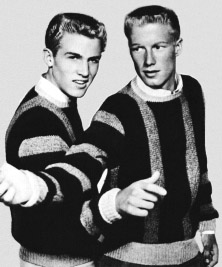
Following the high of hosting one of the all time great, star-studded music movies, Jan and Dean's singles began showing sings of weakness. Like Brian Wilson, Berry and Torrence were huge fans of producer Phil Spector; "You Really Know How to Hurt a Guy" was produced by Jan in a Spectoresque "Wall of Sound" style and hit the top 40 at the start of summer 1965. Sloan and Barri's "I Found a Girl" had more in common with their early recordings and was also a top 40 hit. Jan released another solo single, his one attempt at a protest song, "The Universal Coward" (a takeoff on "The Universal Soldier," a fall '65 hit for both Donovan and Glen Campbell), but like the earlier Berry single, it didn't catch on. Meanwhile, Dean sang on the early 1966 Beach Boys hit "Barbara Ann." When the Batman TV series premiered on ABC-TV in January and immediately dominated in the ratings, the duo released their own "Batman" single (with no similarities to the show's theme by Neal Hefti), a cartoonish take on Gotham City's dependancy on the Caped Crusader.
If the best days were behind them, any chance of a resurgence was extinguished in April 1966 when Jan Berry ran into a parked truck while driving his Corvette Stingray not far from the location detailed so morbidly in "Dead Man's Curve." He suffered brain damage and paralysis resulting in limited use of his limbs, including his legs (doctors diagnosed that he would never be able to walk again). The likelihood of his making records or performing in the future was slim, but Dean continued solo, releasing several singles under the name of the duo. Their contract with Liberty had expired and the label released a few older recordings as singles, including the act's last top 40 hit that summer, "Popsicle" (a remix of a 1963 recording, "Popsicle Truck"). Dean formed the J&D label and licensed one track, "Yellow Balloon," to Columbia Records (competing in the spring of '67 with a version by a band named The Yellow Balloon, which became the hit). He also started his own company, Kittyhawk Graphics, geared specifically toward creating logos and cover art for music acts and, with artist Gene Brownell, won a Grammy Award in the category of Best Album Cover for designing the cover art for the 1971 release by the band Pollution.
There were no further chart appearances for the duo after 1967. Berry rehabbed successfully enough over the next few years to return to studio recording and the two worked together off and on. Live appearances were trickier, as Jan's struggles were all too obvious to concertgoers, but they kept at it and made regular appearances in the '70s and '80s as headliners (with a new backup band, Papa Doo Run Run, named after a variation on the lyrical intro of "The New Girl in School") and as an opening act for longtime colleagues The Beach Boys. Jan Berry passed away in 2004 at the age of 62. Dean Torrence still performs occasionally under the name The Jan and Dean Show in memory of his close friend and musical other half. Music fans will always keep that image of two guys with a "very California look" in their minds and hearts.
NOTABLE SINGLES:
- Jennie Lee - 1958
by Jan and Arnie - Gas Money - 1958
by Jan and Arnie - Baby Talk - 1959
- There's a Girl - 1959
- Clementine - 1960
- We Go Together - 1960
- Gee - 1960
- Heart and Soul - 1961
- Wanted, One Girl - 1961
- Tomorrow's Teardrops - 1961
by Jan Berry - A Sunday Kind of Love - 1962
- Tennessee - 1962
- Linda - 1963
- Surf City - 1963
- Honolulu Lulu - 1963
- Drag City - 1963
- Dead Man's Curve /
The New Girl in School - 1964 - The Little Old Lady (From Pasadena) - 1964
- Ride the Wild Surf /
The Anaheim, Azusa and Cucamonga Sewing Circle, Book Review
and Timing Association - 1964 - Sidewalk Surfin' - 1964
- (Here They Come) From All Over the World - 1965
- You Really Know How to Hurt a Guy - 1965
- I Found a Girl - 1965
- The Universal Coward - 1965
by Jan Berry - A Beginning From an End - 1966
- Batman - 1966
- Popsicle - 1966
- Fiddle Around - 1966
- Yellow Balloon - 1967


